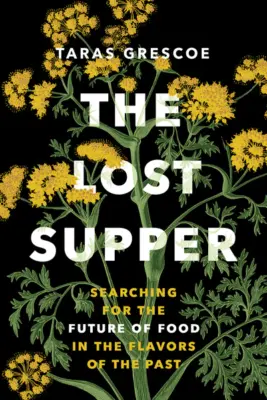From the caviar-like eggs of the Mexican water fly, to ancient olive trees in Puglia, Italy, to camas, the pre-contact root vegetable of the Pacific Northwest, The Lost Supper serves up an alt-gastronomic romp, promising to shuttle the reader back and forth between the foodways of antiquity and the front lines of sustainable agriculture today. If Taras Grescoe seeks to demonstrate that what farmers choose to cultivate and what consumers choose to put on their plates can and should be at once backward- and forward-looking, his vision of humanity’s culinary past remains decidedly more convincing than his ideas about its culinary future.

The Lost Supper
Searching for the Future of Food in the Flavors of the Past
Taras Grescoe
Greystone Books
$39.95
cloth
312pp
9781771647632
However, the organizing logic of other chapters is harder to pin down. Authorial hats – those of food historian, food campaigner, or foodie recreating lost dishes – are stacked on top of each other or swapped in and out in rapid succession. Some of Grescoe’s historical narratives move very fast – the tradition of barbecue is traced from Indigenous Caribbean groups to Spanish colonists to African Americans in a single paragraph – while stories like the deadly Xylella disease that threatens to decimate the monumental olive trees of the Mediterranean come to feel more like lengthy digressions, which leads the book’s future-oriented messaging to fall into the background.
It becomes increasingly clear that The Lost Supper will be more readily enjoyed by gourmands than environmentalists. That Grescoe is explicit about emphasizing the importance of taste for the future of food – “deliciousness isn’t a detail. It really, really matters” – means that his accounts of eating itself are suitably evocative without resorting to clichés, or what he terms “vintage Gourmet magazine food porn.” But it also means that big-picture ethical issues such as vegetarianism and overpopulation are given short shrift. Grescoe’s chapter on the prized Ossabaw Island ham raises questions in particular. Even if meat from “heritage breeds” beats “cheap commodity pork” on almost every metric (except price), why should we be eating pork at all? And might it not be naïve to assert that because sustainably farmed meats are more expensive, consumers will eat less meat in general? If factory-farmed meat is rejected on ethical grounds and factory-made soy-protein burgers are spurned on taste grounds, the stall Grescoe sets out between the two often feels too light on detail.
Ultimately, The Lost Supper struggles to reconcile its nostalgic lens – the desire to “find a way back” to the foodways of a simpler time – with the urgent need for sustainable, nutritional ways of feeding upwards of eight billion human beings. It celebrates rarified foodstuffs even when it is clear-eyed about the impossibility of scaling these up, acknowledging that olive oil cannot be sustainably produced outside the Mediterranean, that the more nutritional results of stone-mills are economically unviable, and that if all urbanites suddenly became foragers, ecosystems would swiftly collapse. As a result, and despite his own efforts, Grescoe’s culinary undertakings risk remaining “a niche pursuit of the privileged few.” Even if he asserts in the epilogue that “there are straightforward ways we can all become more responsible eaters,” readers will likely be left hungry rather than galvanized, more interested in replicating Grescoe’s taste odysseys than radically changing their eating habits.mRb






0 Comments